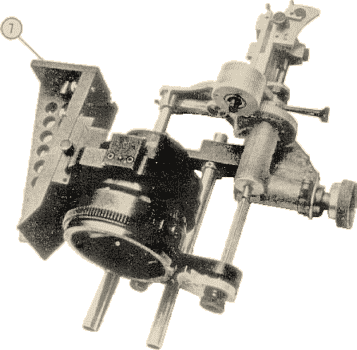In November, 1956, over three years after CinemaScope premiered, American Cinematographer published the following article on a "new" wide screen process from tiny Republic Pictures Corp. Articles of this sort are not especially significant technically, but they do represent small deposit in the time capsule from the era. The "Naturama" lenses used by Republic produced very good pictures, but the puffery and boasting in the article is pretty laughable now, as it probably was in 1956.
MBH(SEE LINK AT THE BOTTOM OF THE PAGE FOR NEW
HIGH RESOLUTION PHOTOS FROM THE PINEWOOD STUDIOS VAULTS)
Naturama - Republic's New
Wide-Screen Process
SINCE THE ADVENT of wide-screen motion pictures in 1952, American Cinematographer has endeavored to keep its readers informed of the details and method of operation of all wide-screen processes, following their introduction.
Naturama is an anamorphic wide-screen system with an aspect ratio of 2.35 to 1. An anamorphic attachment lens is employed in the photography, and is mechanically coupled to the camera lens to achieve simultaneous focus of both lenses.
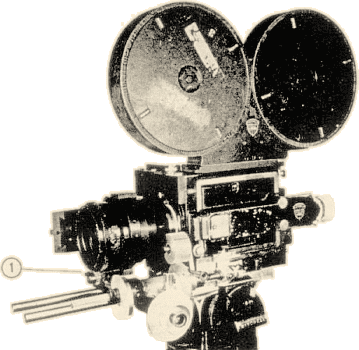 Figure 1 |
Under the supervision of Republic Studios President, Herbert J. Yates, and Daniel J. Bloomberg, Republic's Chief Engineer, the studio's engineering department spent two years in tedious, methodical research work to develop and produce an improved anamorphic lens system which is compatible with all other similar wide-screen processes.
Following a study of every anamorphic lens system already in use or in stages of development, Mr. Yates, early in 1955, ordered specially designed lenses made according to the studio's engineering department's specifications. The lens order was placed with one of the leading optical manufacturers of France which had pioneered in the development of wide-screen optics. Following months of technical revision on the original lenses, a small compact squeeze lens was produced which could be used in conjunction with standard Mitchell camera lenses.
In their effort to improve on existing wide-screen processes, Republic engineers made use of the latest technical knowledge of lens design and the newest types of glass developed for lens manufacture. Preliminary tests indicated greatly improved resolution and definition, with a specific lack of graininess.
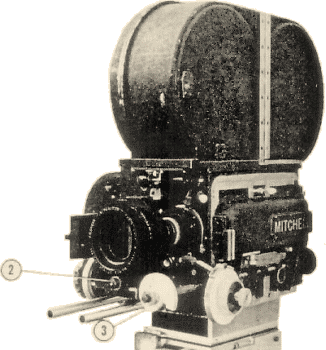 Figure 2 Mitchell BNC camera similarly equipped. Cam (3) actuates rack and pinion gear (2) which engages ring gear of anamorphic lens, focusing it simultaneously with the camera lens. |
Republic's Naturama system is unique in that it is the first to employ an adapter attachment which controls the simultaneous focusing of both the anamorphic and the camera lens. As far as is known, this type of control has not been attempted or perfected by any of the other major studios presently using anamorphic lenses in cinematography. Where anamorphic lens attachments have been used, it usually has been necessary for two camera assistants to individually focus the anamorphic and the camera lens when making follow-focus shots. Inaccuracies in focusing often occurred because of the human element of error thus introduced. With Naturama photography, only one camera assistant is required to handle focusing of both lenses, which is afforded by the single control.
The Naturama wide-screen lens mount and its focusing mechanism were developed especially for use on the Mitchell NC and BNC cameras, which are the cameras used at Republic studio. The anamorphic lens (4, in fig. 3) in close proximity to the camera lens (5, in fig. 3) by a special bracket, which requires only slight alteration of the Mitchell camera case exterior. The bracket is shown at 7 in figure 4, along with the focusing linkage that couples both lenses and affords synchronous focusing.
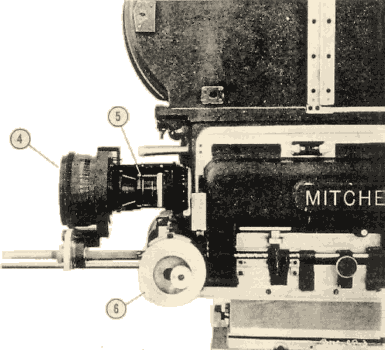 Figure 3 Side View showing Mitchell BNC setup. Anamorphic lens is shown at (4). and the camera lens at (5). Synchronous focusing of both lenses is achieved by one camera assistant operating knob (6). |
The focusing mechanism for the Mitchell NC camera differs slightly from that designed for the BNC, as may be seen in Figs. 1 and 2. For the BNC, the gear train has been re-arranged and enclosed; otherwise it functions the same as the NC arrangement. Focusing control is by means of the single knob (6, fig. 3), which turns the gears meshing with the lens gear ring and at the same time moves the cam (3, Fig. 2).
The cam moves a rack and pinion gear that engages the anamorphic gear ring (1, Fig. 1, and 2, Fig. 2) .
While anamorphic lenses of uniform focal length are used in the Naturama system these may be coupled with a choice of three-camera lenses-50mm, 75mm, and 100 mm. Each camera lens requires a different cam which has been especially designed and machined to produce simultaneous accurate focus of the camera lens with its respective anamorphic lens. To facilitate selection of the proper cam for each lens, figures are engraved on face of the cam identifying it.
|
In William Wade's camera department at Republic studio, a chart is posted that shows which set of three lenses are to be used with a specified Naturama wide-screen lens in conjunction with a particular Mitchell camera. For example, Mitchell BNC camera No. 29 calls for Naturama lens No 39. Which in turn may be used only with 50mm lens No. 493207; 75mm lens No. 499455: or 100 mm lens No.168912. Each of the three lenses has been tested in combination with Naturama lens No. 39 mounted on Mitchell camera No.29. There is a total of six different lens-anamorphic-camera combinations available, utilizing the studio's four Naturama wide-screen lenses and five of its Mitchell cameras.
Following the highly successful filming of "Maverick Queen" in the Naturama process, Republic scheduled practically its entire 1956 production program to be filmed in Naturama. To date, cinematographer Jack Marta, who photographed "Maverick Queen," has also shot "Lisbon" "Affair in Reno," and "Duel at Apache Wells" in the same wide-screen process.
Ellis "Bud" Thackerv. A S.C., has photographed "Thunder Over Reno," and "Accused of Murder" in Naturama, while Jack L. Russell, A.S.C., recently completed filming "Hell's Crossroads" using Republic's new Naturama lenses.
According to Mr. Bloomberg the Naturama system requires no additional equipment for those theatres that are now equipped with wide-screens and wide-screen lenses. He also pointed out that all Naturama productions are being released with an optical sound track in the aspect ratio of 2.35 to 1-the full photographic aperture.
HTML Transcription ©1999 THE AMERICAN WIDESCREEN MUSEUM
Republic was in its death throes in the mid 1950s, which in no way resulted in its films being any worse than they ever had been. Good old Jesse James, that romantic murderer, bank and train robber appeared in a typical black and white Naturama film in 1956. The jungles were teeming with young and wild delinquents who would ultimately move over to American-International and their escapades would be recorded in Colorscope, Vistascope, Superama and ultimately Panavision and color. | ||
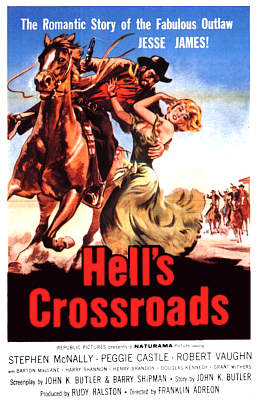 | 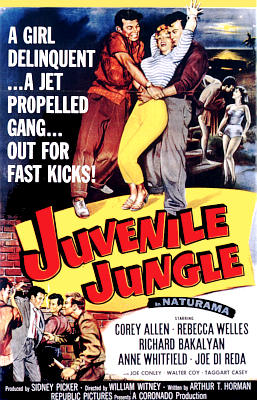 | |
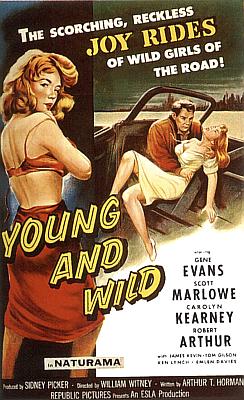 | 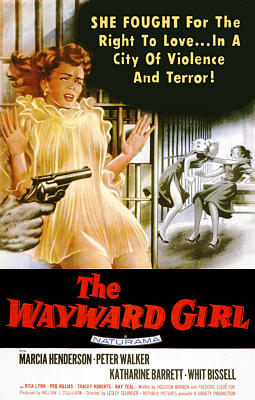 | |
Click Here
